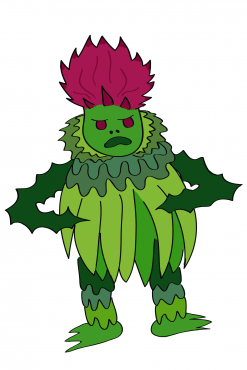
An artistic representation of the invasive plant species on UVic’s campus. Illustration by Leone Brander, Design Director
A comprehensive Invasive Species Management Strategy is coming soon to UVic, with a draft of the adaptive management plan to be made available through the Office of Campus Planning and Sustainability in mid-October.
Balancing a growing university with the value of natural spaces is a recurring dilemma. The management strategy is a single effort to make a more focused movement towards the restoration of UVic’s natural spaces by steering efforts to manage and remove the campus’ invasive species in a coordinated and sustainable way.
The strategy is the result of collaborative efforts across faculties such as the School of Environmental Studies, Facilities Management, and the Office of Campus Planning and Sustainability.
Lindsay Kathrens, a former UVic student and one of the developers at the forefront of the project, believes invasive species to be “one of the most feasible stressors on ecological health in this area that can be dealt with by such a large variety of people in the community from different walks of life.”
“On a human scale,” she explained, “invasive species are the most tangible way we can, on a small scale, go into an area and try and help native ecology regenerate.”
One of the primary invasive species Kathrens and her collaborator, UVic student Julia Jennings, battle is English ivy, which smothers and impedes the growth of other plants. Other threats on the local ecosystem that the strategy focuses on include Scotch broom, English holly, Himalayan blackberry, thistle, daphne laurel, and English hawthorn. The strategy aims to tackle these ecological menaces with targeted invasive species removals, plant walks, native species plantings, and even the repurposing of invasive species in natural plant dyes and ivy weaving.
Jennings and Kathrens both joined UVic’s Ecological Restoration Volunteer Network (ERVN) four years ago, and have since witnessed the many challenges their peers face when conducting campus restoration projects. With that in mind, the strategy will also connect the many past and current environmental restoration efforts around campus, as well as provide a place for student’s work to be used as a reference and continued — even after they graduate.
In addition, new students interested in implementing restoration projects will be able to use the strategy as a basis for identifying priorities they wish to tackle, and effective ways those goals could be accomplished.
“It’s really easy for students to gravitate towards trying to reinvent the wheel,” Kathrens said. “[With this strategy], there’s a foundation already laid for those things to continue which would make efforts more effective, so we want students and other members of the university community to have access to that information and know where they can offer their skills.”
Jennings explained that “students come here for four years and then graduate, and a lot of their projects just get dropped.” Kathrens went on to elaborate that she and Jennings began to notice that “continuity was one of the biggest challenges.”
However, the new management strategy aims to eliminate that problem: A work study student with the ERVN is to be in charge of keeping the strategy updated with various projects and prioritized areas for restoration, and will also serve as the contact point for anyone looking to get involved. Students and professors will also be able to work with the coordinator if they want to integrate the project into their courses.
Anyone interested in getting involved with the ERVN can attend the management strategy open house on Wednesday, Oct. 12, and connect with students involved in a multitude of restoration projects on campus. The open house will allow students and members of the community to provide feedback and ask questions about the strategy, and will take place in the SUB Upper Lounge from 6:30–8:30 pm.








